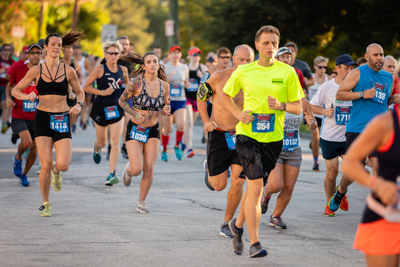Building Fitness: Aerobic Endurance by Susan Paul, MS TSF Training Program Director

Systematic training- Establish a training system. There is a sequence to training that most athletes have found for developing fitness. This system starts with aerobic endurance, moves into lactate threshold training, then aerobic capacity and ends with speed and power training. This sequence progresses over months of training. Building a solid aerobic base foundation takes years, but when done correctly fitness is easily maintained. Once an aerobic base foundation is established, the athlete can then focus on specific goals. Athletes may shift from 5K’s to marathons, sprint triathlons to Ironman distance triathlons relatively easily because they have a solid foundation.
What is aerobic? Sustained physical activities that require the consumption of large amounts of oxygen are termed “aerobic”. The term ‘aerobic’ comes to us from the Greeks and literally means “with air”. Aerobic exercise increases cardio-respiratory function. While performing aerobic exercise, our circulatory and respiratory systems are elevated to deliver oxygen to our muscles to meet this demand. Aerobic exercise is sustained and repetitive in nature and includes activities such as; running, jogging, fitness walking, swimming, and cycling. Tennis, sprinting, weight-training and yoga are not aerobic exercises.
Intensity -The definition of aerobic exercise is that it is able to be sustained for long periods of time. Completing a marathon can take many runners up to 6 or 7 hours. Intensity of exercise is then a very critical factor. The intensity level of sprinting cannot be sustained….jogging can be sustained. Intensity of exercise is measured by heart rate. Aerobic exercise is performed at a percentage of maximal heart rate. Generally speaking, 60-80% of maximal heart rate puts exercisers in their “aerobic zone”. This means heart rate is elevated, but to a sustainable level. A very simple method for calculating your maximal heart rate is to simply subtract your age from 220. This number is considered your maximal heart rate. Then take 60%-80% of your maximal heart to find your aerobic zone.
Energy production- Aerobic exercise, like running, also demands the production of energy (ATP). ATP is supplied during prolonged exercise by the aerobic metabolism of carbohydrates and fats in the mitochondria of the muscles. ATP production comes from a variety of fuels that include muscle glycogen, blood glucose, plasma free fatty acids, and intramuscular fats. For this metabolic chemical reaction to occur, large amounts of oxygen are required, hence the involvement of the respiratory system. Aerobic metabolism is the primary means for supplying energy to the muscle.
The cardiovascular system is responsible for delivering much needed oxygen- enriched blood to the muscles for ATP production. This rapid delivery system elevates our heart rate to meet production level. This delivery system is referred to as “oxygen uptake”.
Maximal Aerobic Power- Maximal aerobic power is the greatest rate at which oxygen can be delivered to working muscles during dynamic exercise. Maximal aerobic power (VO2max) is also the upper limit at which the cardiovascular system can deliver oxygen-enriched blood to the muscles. Maximal oxygen uptake is a good indicator of cardio-respiratory fitness as well as performance capabilities. Some physicians recommend a stress-test or a graded exercise test as part of an annual physical exam because this test assesses the condition of the cardio-respiratory system and is an excellent indicator of overall fitness.
Aerobic endurance- Endurance is the ability to delay the onset and reduce the effects of fatigue. Participating in a 10 to 20 week endurance training program causes an increase in VO2max. Endurance training programs increase VO2max by 5-25%. The magnitude of change depends upon the initial level of fitness of the individual. This means that during training the body adapts physically to meet the demands of the increased activity. In a relatively short period of time, running at the same pace elicits a lower heart rate and a lower breathing rate than prior to exercise training. Consistent, sustained exercise training increases maximal oxygen uptake or VO2max. With the increase in VO2max, the body is now able to meet the demands of aerobic exercise. Distance and pace become easier. As the body continues its adaptation process, runners are able to run farther and faster with less discomfort.
Physical adaptations- An endurance training program stimulates the body to adapt to new physical demands. Many, many changes will occur in the first 6 months of training. Understanding the body’s physiology and the ongoing processes may help athletes better understand the training process. Here is a list of some physical adaptations that occur with endurance training:

2. Skeletal bone strengthens
3. More mitochondria appear in the cell
4. Increased ventricle volume enabling more blood to be pumped out per heart beat
5. Connective tissue strengthens
6. Glycogen stores enlarge
7. Metabolic adaptations allow fuel to be used sparingly
8. Preferential use of fat for energy
9. New capillary beds are constructed
10. Muscle fibers become more oxidative
11. Blood pressure is lowered
12. Resting heart rate is lowered
13. Cholesterol levels are reduced
14. Reduction of body fat
15. Increased muscle mass
These physical adaptations allow the athlete to run farther and faster with less fatigue. The body meets the demand of the workout with relative ease. Allowing the body to adapt is a difficult process for most athletes. We expect immediate results, both in adaptation and performance. Due to our impatience and unrealistic goals and expectations, many athletes are side-lined with injuries before they meet their goal. Practice patience!
Steady state exercise- When the respiratory and cardiovascular systems deliver adequate oxygen to the working muscles, aerobic respiration meets the ATP demand. The rate of oxygen consumption and heart rate level off. This level is called steady state. Breathing and heart rate will remain relatively steady while the runner continues running. Runners experience a feeling of being in a rhythm, as if they could ‘run forever’. Little lactic acid accumulates under steady state conditions. This does not mean that aerobic exercise can continue indefinitely. The depletion of glycogen and blood glucose, fluid and electrolyte loss set limits to endurance and performance.
Endurance training- Distance runners will spend much of their training time in the endurance zone. Running at steady state develops endurance. Aerobic or endurance training increases the number of mitochondria in trained muscles, allowing the aerobic metabolism of carbohydrates and the use of more fat as fuel. As a result, less lactate is produced and the lactate threshold occurs at a higher and higher level of exercise. During aerobic exercise, lactate is metabolized as fast as it is produced.
Developing the aerobic system of energy delivery is the basis of a solid foundation. Build a solid foundation and fitness will last a lifetime. Goals can be re-assessed and changed because the athlete can now move freely in any direction he or she chooses because they have built a solid foundation. Sprint triathlons, marathons, 5K’s, an Ironman, or adventure racing is all possible with a solid foundation.
Practice patience, set realistic goals, and respect your body. Don’t expect immediate results. Allow your body time to adapt to a fitness routine and you will not be disappointed.
Use Facebook to Leave a Comment - We'd love to hear from you.







